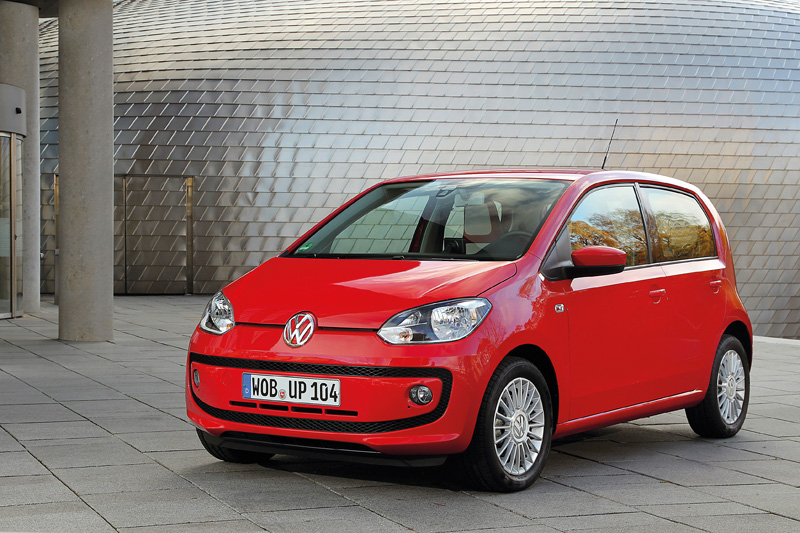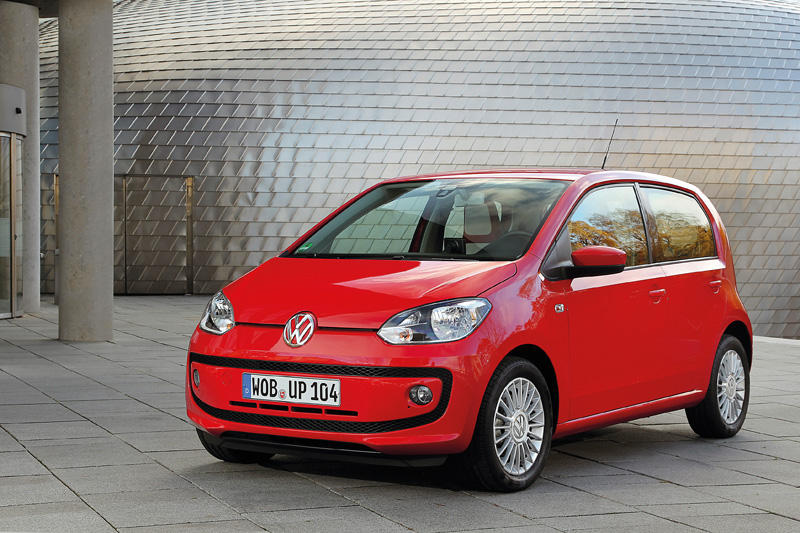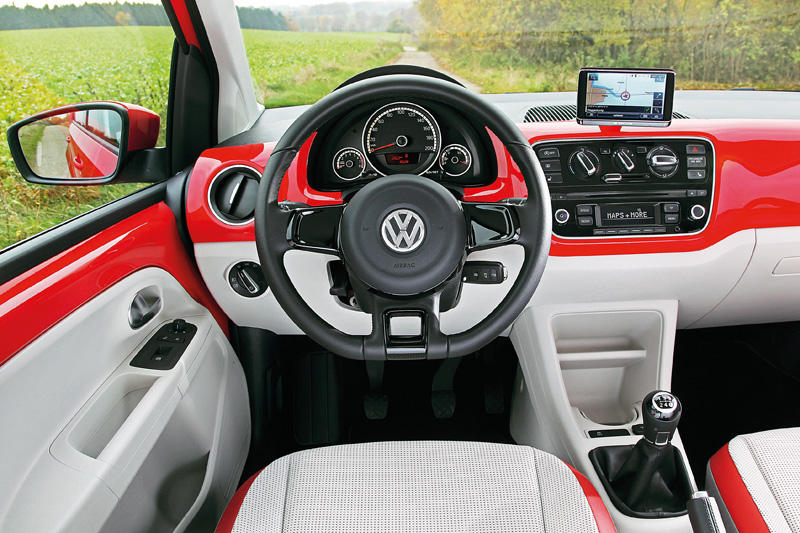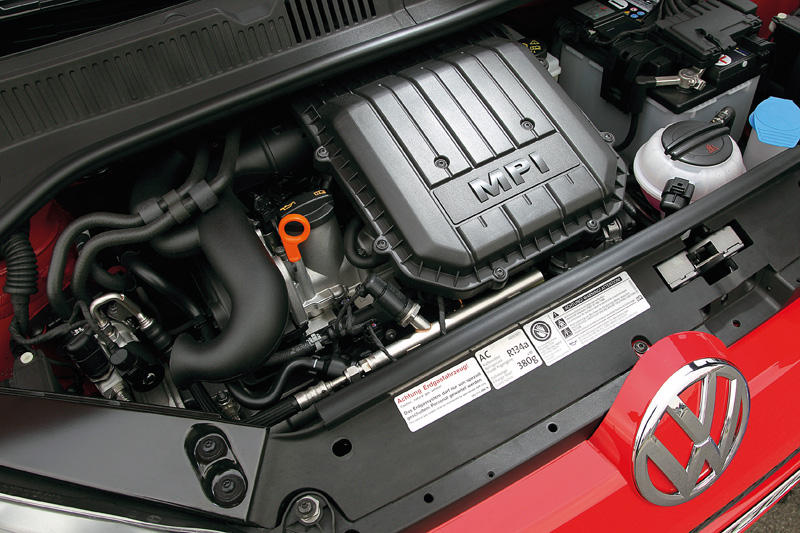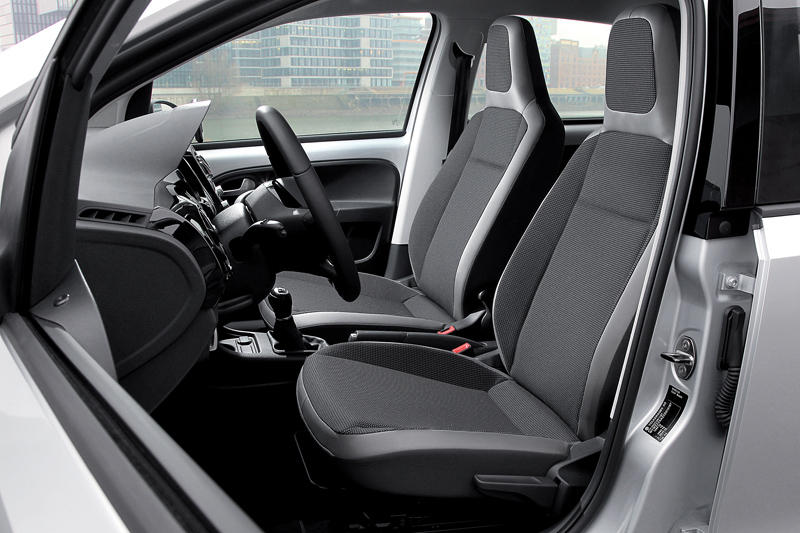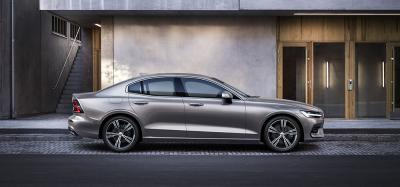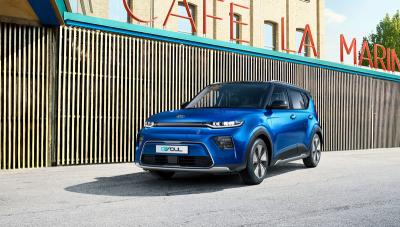UP, but with an exclamation mark! From the very start, the punctuation emphasizes the ambitions of the little German car that made its debut on continental markets after a long gestation period. And the little Volkswagen’s ambitions leave no room for doubt, with its concentrate of advanced solutions in a minute, but attractive body.
Beginning with its clean, modern lines, despite being personal and with elements that recall the family feeling focused most of all in the front section. An image characterized by a wide windscreen that is so steeply inclined that it gives the illusion on continuing the angle of the bonnet. The two ends of the front headlights are connected together by a slim dynamic socket, with the VW logo right in the middle, just in case there is any doubt about the genealogy of this new compact car. Robust sides alleviated by a narrow band give a decidedly high beltline, as the most recent styles dictate, with narrow windows, only two lights and an almost invisible centre pillar. With three or five doors which, aesthetic impact aside, change ease of access to the rear seats but not the space inside, it still seats four people and, all things considered, it is comfortable in the back. There is also enough room in the back for bags and small suitcases in 251 litres that can be increased to 951 litres by folding down the rear seat. Take, Move and High are the three trim levels, but the contents of the basic version are also interesting.
German rationality
At just a fraction longer than the 3.50-metre reference for compact cars primarily for city use, the little Volkswagen is 1.64 metres wide and 1.48 metres high and was conceived to meet the main needs of urban mobility, economy and handling. Not only by dipping into the group’s know-how, but also by creating targeted solutions that made their debut in the Up!, kept industrial costs at an acceptable level and, as a consequence, a purchase price that is in line with its main competitors in Italy, France and Japan. Beginning with a particularly rigid chassis made lighter by the very precise design of the joints, which reduces, for example, the need to cut down interior noise with soundproofing and keeps total vehicle mass down to 929 kg. The front axle is reinforced with a steel structure for supporting the suspension and benefits from a layout with independent wheels and triangular arms below, while the compact rear axle has interconnected wheels, helical springs and hydraulic shock absorbers. An option, and naturally available only with the top High Up! version, is the 15-mm lower sport chassis with stiffer shock absorbers and low profile tyres on alloy rims that are bigger than the ones on its less pretentious little sisters.
A more careful use of interior space by reducing to a maximum dead spaces and the thickness of the panel covering is shown in the particularly airy cabin considering the external dimensions, where a clean shape goes hand in hand with the lines of the body designed by Walter De Silva, head of design at Volkswagen. The linear dashboard has a brow over the instrument cluster with three circular dials, a central stack with climate and audio controls surmounted by a removable Maps+More display system, which comes as standard only in the High Up! version at the top of the range. Even the entry level includes front and side airbags, front and rear headrests, height adjustable steering column (with electric power steering) and CD/MP3 audio system with Aux-In socket. There are numerous storage areas, holders for 1-litre drinks bottles and a large drawer with pen and coin holders facing the front seat passenger.
The highlights offered at various levels include the City emergency brake that monitors the distance from the vehicle in front and automatically slows the car down if a collision is imminent, Electronic Stability Program, ABS, Hill Holder, Park Pilot rear parking sensors, and a dedicated infotainment system Maps+More with a 5” touchscreen display that includes the navigator, hands-free phone connection, multimedia reader and display of vehicle operation.
Three is the perfect number
Not escaping notice in the plethora of new developments is the new Otto cycle three-cylinder 999 cc engine, configured with two power levels, 60 HP – and therefore accessible also for new licence holders – and 75 HP maximum, both with 95 Nm torque between 3,000 and 5,000 rpm, 90% of which is already available at 2,000 rpm. A dual configuration that is very attentive to energy efficiency, with declared consumption decidedly low at, respectively, 23.8 km/litre (and CO2 emissions of 97 g/km) for the BlueMotion version, and 23.3 km/litre, against non-spectacular but adequate performance for its purpose, with a top speed of 160 and 171 km/h, and 0-100 km/h acceleration in 14.4 and 13.2 seconds, respectively, a few tenths more if fitted with automatic transmission.
Like the engines, the gear box is also completely new and entirely in aluminium for maximum weight containment (the lightest in the world at just 25 kg, including oil); it has 5 manual gears and is set up also for the 5-gear automatic version.
Rationality also comes in the choice of rims and tyres, with standard sizes of 165/79 R14 for Take Up! and Move Up!, availability of bigger 175/65 and 185/55 tyres, respectively, with 14” steel rims and 15” alloy rims, while the richer High Up! version has 16” alloy rims with low profile 185/50 R16 tyres.
In line with the innovative philosophy of the range, the new additions don’t stop here: while waiting for the Up! with electric traction announced for the end of 2013, soon to be introduced to the market is the EcoFuel, which is gas-powered, particularly appetizing as far as running costs are concerned, highly environment friendly and considerably economical. Fitted with the same three-cylinder engine, in this case capable of a maximum of 68 HP and optimized compression for better combustion, the Up! EcoFuel will have two gas tanks holding a total of 11 kg, in addition to an auxiliary 10-litre tank for petrol. In this case, expected consumption is around 2.9 kg of gas every 100 km at a cost of less than 3 euros.
